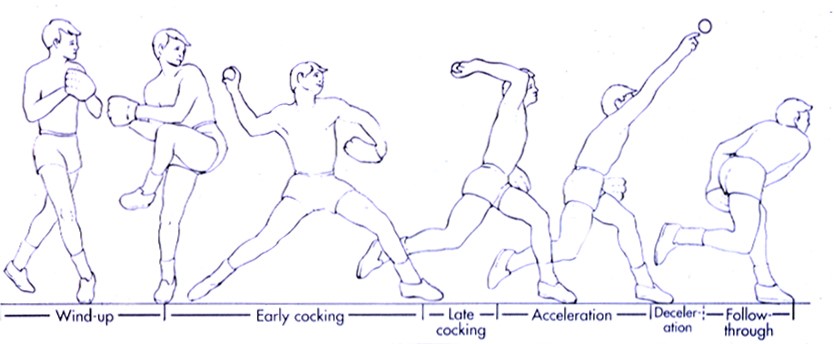The Role of the Kinetic Chain
The Kinetic Chain is a term used by most sports medicine and exercise science professionals to describe a sequence or a chain of events that take place in order for an athlete to throw (Figure 1). For a pitcher, the sequence of events start from the push off of the rubber on the mound to the follow through where the pitcher rolls off of the mound.

When I evaluate a young throwing athlete I often am asked “Why Are You Looking at His/Her Hip, Shoulder When It’s the Elbow that’s the Problem.”
Unfortunately all too common as all they are concerned about is when he or she can pitch/throw again. The throwing motion is a very violent motion and it takes many moving parts at a high speed. If any of those parts is out of balance (weak, tight, pain) then the result can be less than optimum. Continued throwing in this unbalanced condition can result not only in injury, missing games but season ending and sometimes career ending injuries.
The hip like any other joint is subjected to fatigue as the result of the repetitive actions of throwing. The position of the hip “sets up” the upper extremity for the throwing motion. The lead (landing leg) hip lands in 5-25 degrees of internal rotation, setting the proper rotation. If the hip opens too early, it can result in increased stresses across the shoulder and elbow. If the hip opens too late, you wind up throwing across the hip and losing power. The trail hip stabilized the pelvis and controls the stride length.
In 2009 Dr.’s Aguinaldo and Chambers from Rady Children’s Hospital in San Diego, California did a biomechanical study of 69 adult pitchers throwing off and indoor mound. They showed that late trunk rotation was a cause of increases stresses across the elbow (load on ulnar collateral ligament).
What does this mean for the throwing athlete? The baseball season is a long one and these athletes are subject to fatigue, overuse and joint adaptions during the season. Loss of hip rotation, strength can gradually occur if not addressed resulting in increases stresses across the shoulder and elbow. Decreased hip rotation can also cause sacroiliac and back problems. What about velocity? You may be surprised to know that close to 50% of the velocity of throwing comes from the energy initiated below the waist. This is another reason why a complete training program including the pelvis, hip, scapula AND shoulder are critical to the success of the throwing athlete.
Numerous studies have shown that deficits and upper/lower body strength and flexibility can be correlated with injuries the shoulder and elbow of the throwing athlete.
Bottom line, let’s do our best to help our young throwing athletes. In addition to pitch counts (by age) and type of throw (by age) let’s allow our athletes to be prepared physically and mentally to enjoy the game as it is meant to be played.
I would recommend pre and post season evaluations to be sure any deficits are identified to hopefully prevent injuries and keep those shoulder and elbows healthy for a long time.
